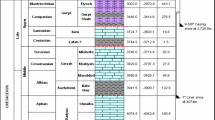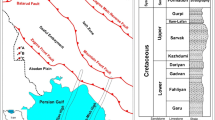Abstract
Selection of proper failure criterion is one of the most important task in analyzing wellbore stability analysis. While the Mohr-Coulomb criterion is still commonly used, its prediction of the safe mud weight supporting the wellbore wall is usually too high because this zone is predicted to yield without any shear failure around the borehole. The main purpose of the paper is to discuss pros and cons of some existing criteria such as Mohr-Coulomb, Hoek-Brown and modified Lade failure criterion. Then the allowable drilling mud pressures calculated by using these methods are compared with each other and with the field data. Two wellbores in two Bach Ho oilfields are considered as case studies in order to identify the criterion that is able to provide the closest agreement with the field data.
Access provided by Autonomous University of Puebla. Download conference paper PDF
Similar content being viewed by others
Keywords
1 Introduction
Geomechanical model is used for well design process in petroleum exploration and production in Vietnam. The aim of this application is to prevent well problems during drilling or production such as breakout, mud loss, lost circulation, wellbore collapse and drilling cost reduction. In well trajectory design, engineers based on various calculation models [1] which is similar with wellbore stability analysis in minimum mud weight determination by using failure analysis rock. Generally these applications require several geomechanical parameters, for instance well condition (azimuth angle, inclination angle), in-situ stress (vertical, horizontal stress), rock mechanical properties (poisson’s ratio, cohesion, internal friction angle, uniaxial compressive strength UCS, TWC external collapse). In some cases, non-destructive strength tests is essential solution of rock properties determination with the indicators of rock detected by logging tools (gamma Ray GR, density, sonic compressional transit time DTCO, and sonic shear transit time DTSM logs).
In terms of wellbore stability analysis, there are there important parameters should be stated: reasonable mud weight (MW), drilling fluid inhibition and sealing ability with several impact factors such as in situ stresses, pore pressure, rock strength, drilling operation. In the present paper, we consider only the mud weight selection which can result to shear failure around the wellbore, as a result there is hole enlargement or breakout, washout, even hole-collapse. There are a number of published geomechanical models, rock mechanical properties estimation. These results are developed for particular rock type, age, depth range, field or even a basin while their applications to another rock may not reliable. This paper first will present briefly analytical solution for wellbore stability, and then a specific case study application for X-well of Bach Ho field in Vietnam.
2 Analytical Solution for Wellbore Stability of a Deviated Well
2.1 Stress Distribution Around a Wellbore
The rock material is generally assumed as a continuous homogeneous and isotropic porous media.
Figure 1 illustrates the stress distribution around a deviated well path subjected to in-situ on different coordinate systems, which was reported in [2].
Stress coordinate transformation around wellbore [2]. (a) deviated well trajectory under in-situ stress; (b) coordinate conversion for deviated well.
The stress components at the boundary of the plane-strain problem can be expressed in the follow equation for vertical and horizontal well respectively.
2.2 Rock Failure Criteria
Well design process generally requires a careful selection of rock failure criterion. The common criterion used for wellbore stability analysis is the Mohr-Coulomb criterion (Eq. 1) [3]. However this criterion involves only the maximum principal stress and the minimum principal stress, and so the intermediate stress has no influence on rock strength. There was some new proposed criteria to ameliorate this disadvantage but the determination of parameters were complicate. This paper mainly focuses on two criteria named Hoek-Brown and Modified Lade, which are summarised in the Eqs. (4) and (5) respectively.
Where: \( \sigma_{r} ,\;\sigma_{\theta } ,\;\sigma_{z} ,\;\tau_{\theta z} ,\;\tau_{r\theta } ,\;\tau_{rz} , \): stress components in cylindrical coordinate; \( \sigma_{v} ,\;\sigma_{H} ,\;\sigma_{h} \): in-situ principal stresses, vertical stress, major horizontal stress, minor horizontal stress respectively; \( \sigma_{1} ,\;\sigma_{2} ,\;\sigma_{3} \): principal stresses; Pw: internal wellbore pressure; \( \theta \): rotation angle; \( \tau_{0} ,\;\varphi \): cohesion of the material, and angle of internal friction; \( S,\;\eta ,\;\nu \): material constants, Poison’s ratio; \( K_{p} = \frac{1\, + \,\sin \phi }{1\, - \,\sin \phi } \).
3 Wellbore Stability Analysis and Discussions
Based on X-well data of Bach Ho field in Vietnam, the data shown in the Table 1 for the depth of TVD = 98,437 ft, vertical well, vertical stress \( \sigma_{v} \) = 822.56 psi, horizontal stress (\( \sigma_{H} \) = 7236.31 psi, \( \sigma_{h} \) = 6702.42 psi), uniaxial compressive strength UCS = 4493.33 psi, pore pressure Pp = 4180.93 psi. The calculation of tangential stress shows in the Fig. 2. Since the tangential stresses with max value of approximately 9000 psi are lower than uniaxial tress strength of 9100,31 psi it could be concluded that there is no compressive damage around the wellbore.
Regarding the wellbore stability problems, a number of running tests with the data in the Table 1 but the mud weight of this works is unknown. The task is to choose the mud weight which is below value in the Fig. 3 corresponding shear stress and in this paper we have considered all three criteria given in the Eqs. (3)–(5). The figure illustrates that the similar trend of change mud weight versus inclination angle of the well. Overall, the higher inclination angle of the well will requires the higher value of mud weight, exception azimuth angle of 90°. The lowest mud weight can be used is for vertical well for Mohr-Coulomb, Hoek Brown, and Modified Lade, around 7.6 lb/gal, 7.5 lb/gal, 6.1 lb.gal respectively, except the well with azimuth angle of 90° which has the lowest mud weight requirement for well inclination of 50°.
By contrast, the highest mud weight need to used is for horizontal well for three criteria. In addition, there is no different of mud weight can be used for two wells with azimuth angle of 0° and 30°. The results also show that wells which are drilled at azimuth angle of 90° require lowest mud weight for any well inclination compared to other cases of azimuth angle.
4 Conclusion
This paper has presented campaign test on stress distribution around wellbore and results of three rock failure criteria applied to a case study of X-well data in Bach Ho field, Vietnam. The following concluding remarks could be drawn from the study:
-
There is no rock damage around wellbore
-
Modified Lade predicts the lowest mud weight requirement while the Mohr-Coulomb gives the highest value
-
Safest wellbore stability of drilled well at azimuth angle of 90°.
References
Zhiyue, W., Deli, G.: Trajectory optimization for horizontal shale gas well by integrating wellbore stability. ARMA 17-307 (2017)
Ma, T., Chen, P., Yang, C., Zhao, J.: Wellbore stability analysis and well path optimization based on the breakout width model and Mogi-Coulomb criterion. J. Petrol. Sci. Eng. 135, 678–701 (2015)
Nguyen, V.H., Gland, N., Dautriat, J., Guelard, J., David, C., Wassermann, J.: Experimental study and modeling of the hydromechanical behavior of a weakly consolidated sandstone under proportional triaxial compression stress paths. ARMA 2012-430 (2012)
Acknowledgements
This work is funded by Petrovietnam University under grant code GV1702, we would like to thank to the board of manager of PVU for the support.
Author information
Authors and Affiliations
Corresponding author
Editor information
Editors and Affiliations
Rights and permissions
Copyright information
© 2019 Springer Nature Singapore Pte Ltd.
About this paper
Cite this paper
Nguyen, V.H. et al. (2019). Application of a Geomechanical Model to Wellbore Stability Analysis: A Case Study X-Well, Bach Ho Field in Vietnam. In: Randolph, M., Doan, D., Tang, A., Bui, M., Dinh, V. (eds) Proceedings of the 1st Vietnam Symposium on Advances in Offshore Engineering. VSOE 2018. Lecture Notes in Civil Engineering , vol 18. Springer, Singapore. https://doi.org/10.1007/978-981-13-2306-5_23
Download citation
DOI: https://doi.org/10.1007/978-981-13-2306-5_23
Published:
Publisher Name: Springer, Singapore
Print ISBN: 978-981-13-2305-8
Online ISBN: 978-981-13-2306-5
eBook Packages: EngineeringEngineering (R0)







